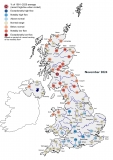Submitted by Steve Turner on
April was an exceptionally dry, sunny and cool month, an unusual combination of low rainfall and temperatures for the time of year (scatterplot on third page). It was both the frostiest and sunniest April on record for the UK (in series from 1960 and 1919, respectively), and in the Central England Temperature series it was the second coldest April since World War Two. For the UK, rainfall was 29% of the long-term average, the driest April since 1980 and fourth driest in a series from 1910; substantial parts of southern and eastern England recorded little appreciable rainfall. Soil moisture deficits (SMDs) increased across the UK in April and soils were substantially drier than average for the time of year; late April soil moisture in the South West region was the driest on record (in a series from 1961). Having receded throughout the month, river flows were below normal or lower across most of England, Wales and Northern Ireland, less than half of average across western areas, and notably or exceptionally low in south-west England and Northern Ireland. The lack of recharge across the UK in April meant groundwater levels fell in all aquifers, and whilst levels at several boreholes were in a lower category than at the end of March, they generally remained within the normal range or above. Whilst reservoir stocks fell, totals for England & Wales remained near average. However, stocks in some reservoirs were substantially below their late April average (e.g. by more than 20% at Loch Thom); previous late April minimum stocks were equalled at Washburn and eclipsed at Loch Thom (in series from 1988). At the end of April, whilst healthy in the English Lowlands, the outlook for late spring and summer in the responsive north and west was more tentative given low flows and some declining reservoir stocks. However, substantial rainfall over the first fortnight of May has provided some respite from the sustained dry weather of spring. Across most of the UK, average May rainfall has already been recorded (and substantially exceeded in the north and west), likely ameliorating concerns for water resources.



